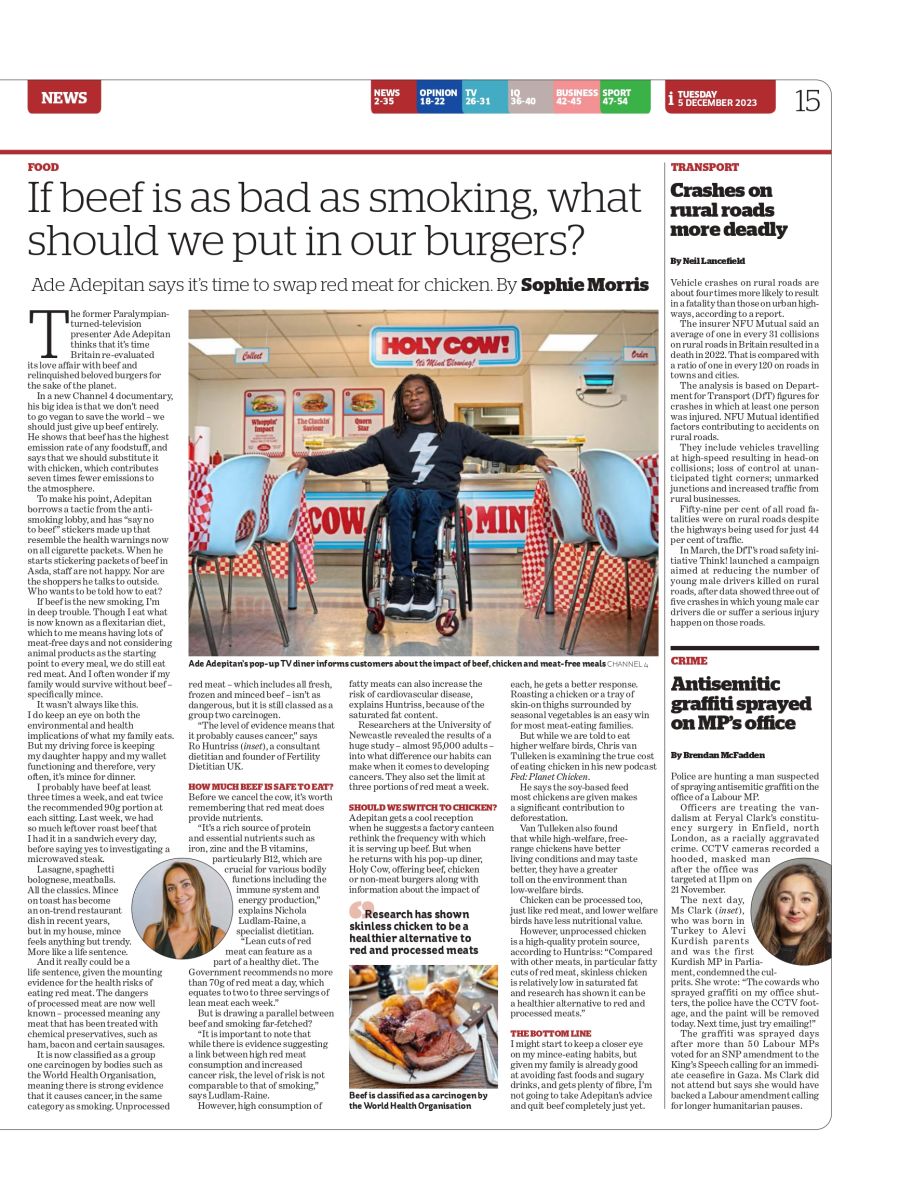
The former Paralympianturned-television presenter Ade Adepitan thinks that it’s time Britain re-evaluated its love affair with beef and relinquished beloved burgers for the sake of the planet.
In a new Channel 4 documentary, his big idea is that we don’t need to go vegan to save the world - we should just give up beef entirely. He shows that beef has the highest emission rate of any foodstuff, and says that we should substitute it with chicken, which contributes seven times fewer emissions to the atmosphere.
To make his point, Adepitan borrows a tactic from the antismoking lobby, and has “say no to beef ” stickers made up that resemble the health warnings now on all cigarette packets. When he starts stickering packets of beef in Asda, staff are not happy. Nor are the shoppers he talks to outside. Who wants to be told how to eat?
If beef is the new smoking, I’m in deep trouble. Though I eat what is now known as a flexitarian diet, which to me means having lots of meat-free days and not considering animal products as the starting point to every meal, we do still eat red meat. And I often wonder if my family would survive without beef - specifically mince.
It wasn’t always like this. I do keep an eye on both the environmental and health implications of what my family eats. But my driving force is keeping my daughter happy and my wallet functioning and therefore, very often, it’s mince for dinner.
I probably have beef at least three times a week, and eat twice the recommended 90g portion at each sitting. Last week, we had so much leftover roast beef that I had it in a sandwich every day, before saying yes to investigating a microwaved steak.
Lasagne, spaghetti bolognese, meatballs. All the classics. Mince on toast has become an on-trend restaurant dish in recent years, but in my house, mince feels anything but trendy. More like a life sentence.
And it really could be a life sentence, given the mounting evidence for the health risks of eating red meat. The dangers of processed meat are now well known - processed meaning any meat that has been treated with chemical preservatives, such as ham, bacon and certain sausages.
It is now classified as a group one carcinogen by bodies such as the World Health Organisation, meaning there is strong evidence that it causes cancer, in the same category as smoking. Unprocessed red meat - which includes all fresh, frozen and minced beef - isn’t as dangerous, but it is still classed as a group two carcinogen.
“The level of evidence means that it probably causes cancer,” says Ro Huntriss (inset), a consultant dietitian and founder of Fertility Dietitian UK.
HOW MUCH BEEF IS SAFE TO EAT? Before we cancel the cow, it’s worth remembering that red meat does provide nutrients.
“It’s a rich source of protein and essential nutrients such as iron, zinc and the B vitamins, particularly B12, which are crucial for various bodily functions including the immune system and energy production,” explains Nichola Ludlam-Raine, a specialist dietitian.
“Lean cuts of red meat can feature as a part of a healthy diet. The Government recommends no more than 70g of red meat a day, which equates to two to three servings of lean meat each week.”
But is drawing a parallel between beef and smoking far-fetched?
“It is important to note that while there is evidence suggesting a link between high red meat consumption and increased cancer risk, the level of risk is not comparable to that of smoking,” says Ludlam-Raine.
However, high consumption of fatty meats can also increase the risk of cardiovascular disease, explains Huntriss, because of the saturated fat content.
Researchers at the University of Newcastle revealed the results of a huge study - almost 95,000 adults - into what difference our habits can make when it comes to developing cancers. They also set the limit at three portions of red meat a week. SHOULD WE SWITCH TO CHICKEN? Adepitan gets a cool reception when he suggests a factory canteen rethink the frequency with which it is serving up beef. But when he returns with his pop-up diner, Holy Cow, offering beef, chicken or non-meat burgers along with information about the impact of each, he gets a better response. Roasting a chicken or a tray of skin-on thighs surrounded by seasonal vegetables is an easy win for most meat-eating families.
But while we are told to eat higher welfare birds, Chris van Tulleken is examining the true cost of eating chicken in his new podcast Fed: Planet Chicken.
He says the soy-based feed most chickens are given makes a significant contribution to deforestation.
Van Tulleken also found that while high-welfare, freerange chickens have better living conditions and may taste better, they have a greater toll on the environment than low-welfare birds.
Chicken can be processed too, just like red meat, and lower welfare birds have less nutritional value.
However, unprocessed chicken is a high-quality protein source, according to Huntriss: “Compared with other meats, in particular fatty cuts of red meat, skinless chicken is relatively low in saturated fat and research has shown it can be a healthier alternative to red and processed meats.”
THE BOTTOM LINE I might start to keep a closer eye on my mince-eating habits, but given my family is already good at avoiding fast foods and sugary drinks, and gets plenty of fibre, I’m not going to take Adepitan’s advice and quit beef completely just yet.